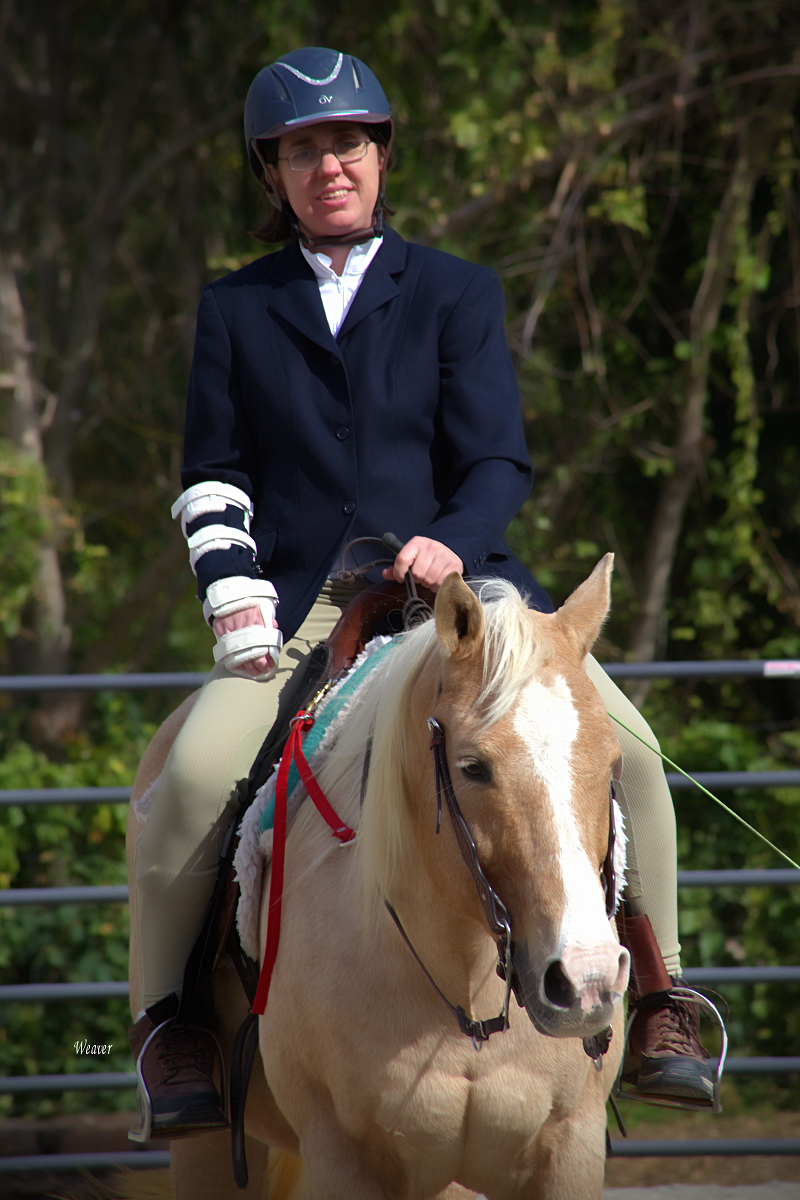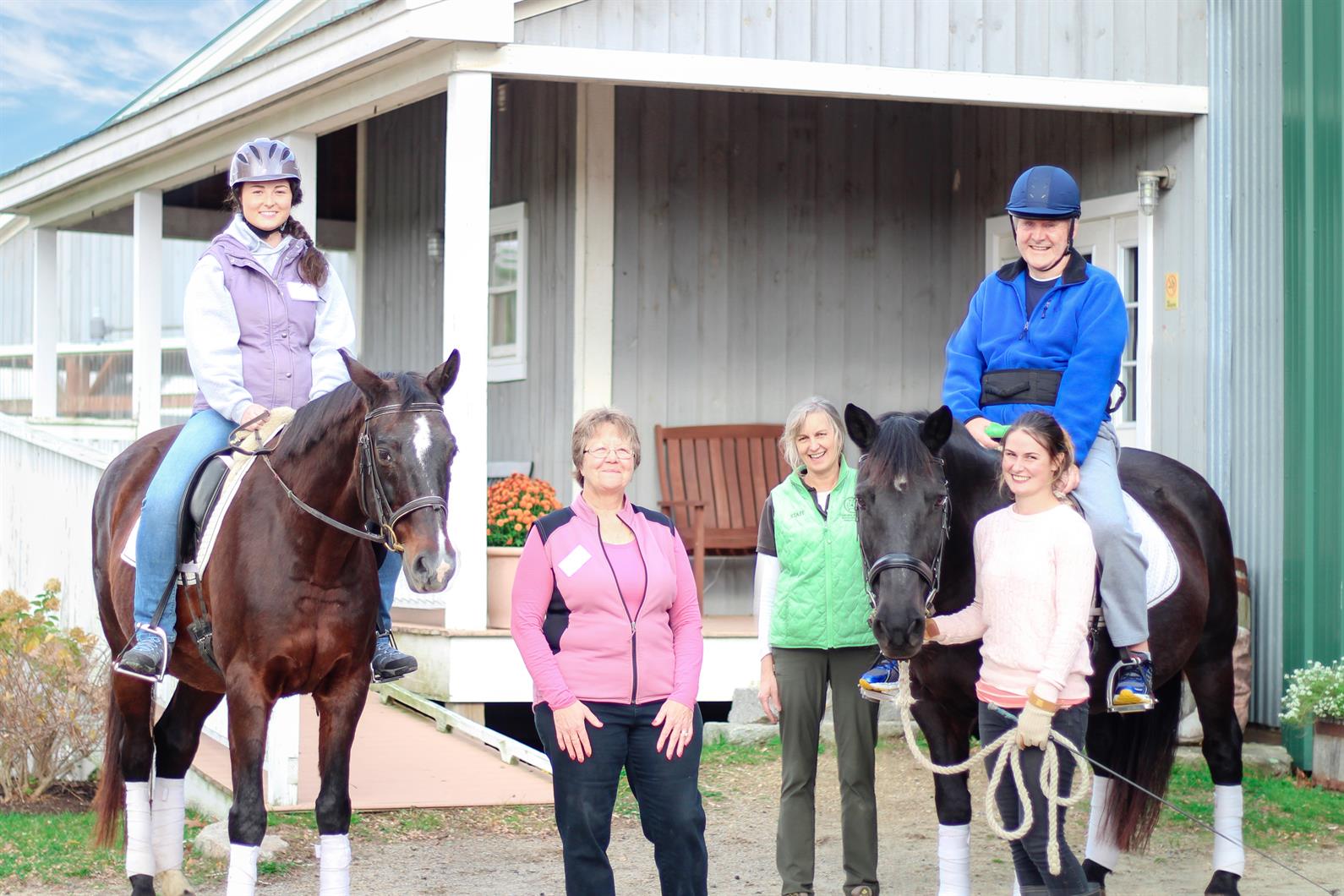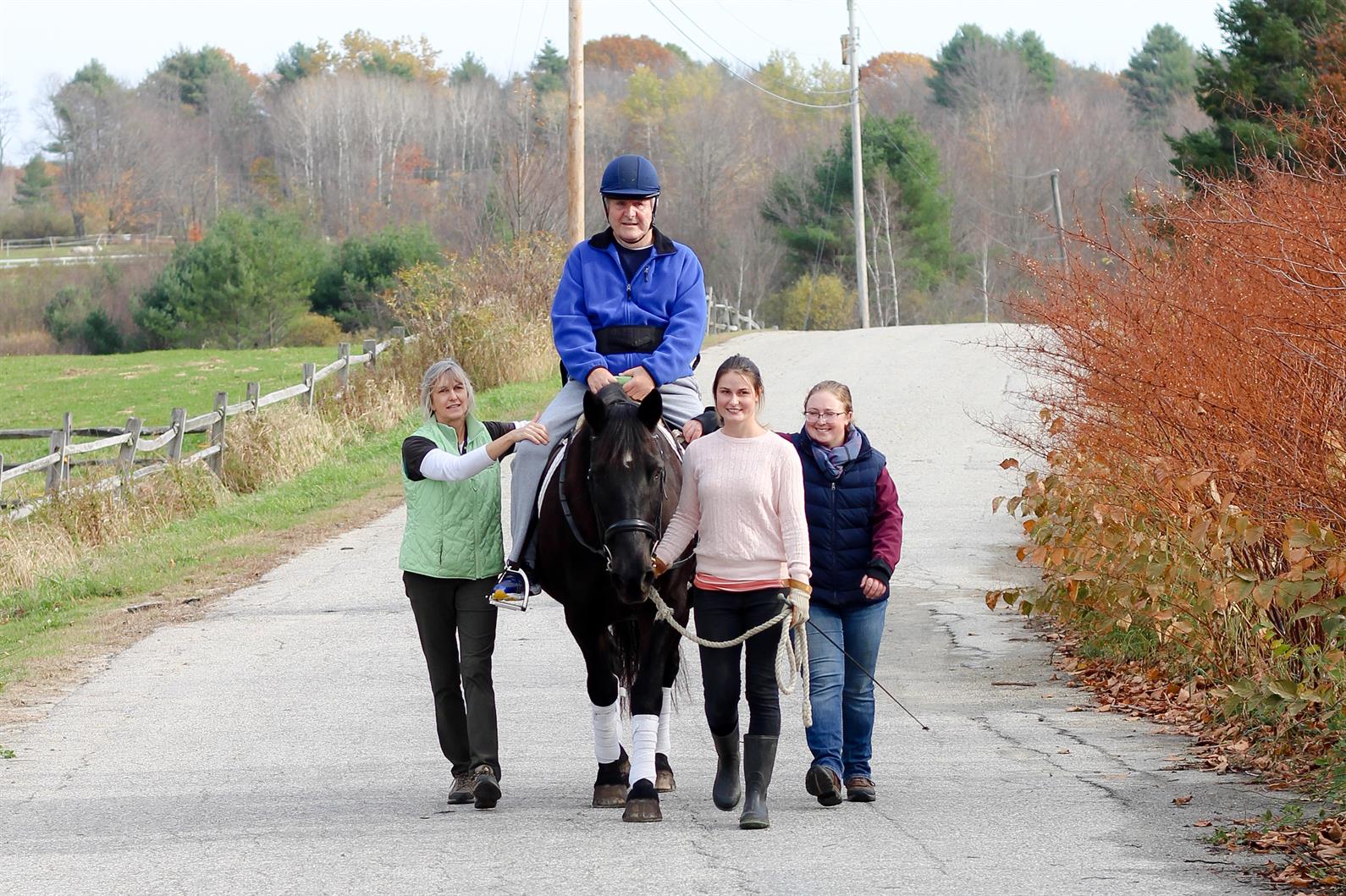When U.S. Army veteran Seyward McKinney took fifth place recently in a dressage competition at the Virginia Horse Center with a Quarter Horse mare named Trinity, it wasn’t just any result. It was an important early milestone in what McKinney hopes will become a competitive para-dressage career, thanks to programs that are introducing military veterans to horses—often for the first time—both for therapy and for sport.

McKinney, 33, served as an operating room technician in the Army’s 31st Combat Support Hospital in Baghdad, Iraq. She had a few close brushes with catastrophe—most notably when a rocket just missed her while she was dropping her clothes off at a laundry near the emergency room—but it wasn’t until she returned from Iraq that she sustained the physical trauma that would change her life. In 2009, McKinney was diagnosed with an arteriovenous malformation in her brain, and, after a series of surgeries, she had a stroke when one of the blood vessels in her brain leaked. At age 25, the previously athletic young woman—who had once run cross-country and founded the first girls’ soccer team at her high school—was now paralyzed on her right side. After two years at the Walter Reed Army Medical Center in Washington, D.C., she is now back home in Salem, Va.
That didn’t stop McKinney’s athletic pursuits. She took up riding at Fort Myer in Arlington, Va., in a therapeutic riding program that paired wounded veterans with horses whose day job was to pull the caissons during military funerals at Arlington National Cemetery. Since then, she has ridden on drill teams and taken up recumbent cycling; she won a gold medal in cycling and a bronze in shotput at the 2010 Warrior Games. Today, she rides twice a week at Healing Strides of VA in Boones Mill, Va., one of six USEF/USPEA National Para-Equestrian Dressage Centers of Excellence, where she hopes to launch a competitive career in para-dressage.
“I’ve got to keep doing competitions and more stuff so maybe I can get involved in the Paralympics program,” said McKinney, who says she particularly likes the challenge that dressage’s precise patterns require.

In the meantime, according to McKinney and her mother Ricki, the regular interactions with horses and the exercises she does as part of her riding program have brought McKinney many benefits, both physical and mental.
“When I’m on the horse, I have to make sure I’m up tall and my shoulders are back,” said McKinney. “Balance is a big thing.”
“Her balance is a little better, and her right leg is a lot stronger,” said her mother. “There was a time when she would ride and there would be a person in front and two people on either side of her. Now they’re not doing that at all anymore, so she’s obviously progressed.
“Anything that she wanted to do, her father and I were glad to see her do it,” Ricki added. “Anything to get her out and doing things, we were all for that.”
Community and a Sense of Peace
“The reason veterans are attracted to horses are the same reason anyone is attracted to horses: it’s that same sense of freedom and independence that we all get from riding a horse and that same connection we have with the horse,” said Megan McQueeney, a United States Dressage Federation bronze and silver medalist who has been teaching riders with disabilities for more than a decade. She’s a Professional Association of Therapeutic Horsemanship (PATH) International advanced instructor at Ride On Therapeutic Horsemanship, a USEF/USPEA National Para-Equestrian Dressage Center of Excellence in Chatsworth, Calif. “The whole reason we like it is because the horse is a living, breathing animal that it’s so compelling to have a partnership with.
“At the same time, providing that to veterans can be a little more complicated,” McQueeney continued. “We try to serve veterans and their families, and there’s a huge diversity within the veteran population of what they’re looking for and what they want. The critical part is to try to figure out what it is that particular veteran wants and needs.
“For some, they’ll want to come with their whole family, and the kids might also want to ride. Some veterans might not want to ride—maybe they just want to be around the horses and reconnect with their families through horses. Others will want to learn to ride—they might have a disability or they might not—but they want to feel that they have that capability on a horse.”
Whatever a veteran’s particular background—combat veteran or not, young or old, ill or wounded physically or mentally—there are many types of programs that can offer help, including adaptive riding, equine-assisted psychotherapy, hippotherapy, therapeutic riding, and sport programs.
“The words we often hear are, ‘I need a place of peace,’ and we all know horses bring that to us,” said Carol Young, executive director at Healing Strides of VA, which serves about 200 people each week, including about 22 veterans of various ages, including veterans from World War II, Korea, Vietnam, Afghanistan, and Iraq. “We also hear, ‘I need to feel like I’m part of something again.’ Those are the two critical pieces that they’re missing when they get back: to find a place that is peaceful and to belong to something bigger than themselves.”
Program officials and participants alike agree that the horses are critical to the healing process for veterans with physical and/or mental wounds, and they are crucial partners in helping veterans improve such skills as effective communication and patience.
“Horses meet them exactly where they are,” said Young. “A horse lives in a hypersensitive world and they are hyper-vigilant. They want to know, ‘Can I trust you?’ And that’s where a lot of veterans are. You can’t be incongruent with a horse; you have to be in congruency with yourself, because the horse picks up on that as someone to move away from. So the veterans learn that they have to get straight within themselves.
“Most of our veterans also volunteer back into our program,” Young added. “If you think about it, that heart of service that typically took them into the military to begin with makes them want to help others, too.”
A New World of Sport—and Joy
That sense of community is a significant plus, as are the interactions with the horses, says 75-year-old Peter Breton, a U.S. Air Force veteran in Woburn, Mass., who developed the neurological disorder Guillain-Barré syndrome, which can cause extreme weakness and paralysis, about nine years ago. Breton, who has quadriparesis—muscle weakness affecting all four limbs—had been in a physical therapy program but felt his progress had stalled, and so he tried the program at Carlisle Academy Integrative Equine Therapy and Sports in Lyman, Maine.

“The first thing that impressed me was how calm the horses were,” said Breton, who had no prior experience riding horses. “I started off just grooming horses, and it was interesting to see how calm they were and how well they listened to the people that were handling them.”
In his most recent six or seven sessions, Breton has begun riding, accompanied by a team that includes “side-walkers” alongside the horse. He already sees positive changes.
“At night when I’m getting ready for bed, my wife used to have to pull me forward to take off my shirt,” Breton said. “Now—and I think it’s since we started going to Carlisle Academy—I can sit up by myself so she doesn’t have to pull me forward anymore. It feels like my core muscles are getting stronger. I’m gaining a lot of self-confidence, and it’s giving me a big feeling of independence, which is important to somebody in my position.”
“It’s been kind of a change of perspective, too,” added Carol Breton, Peter’s wife. “Before we started at Carlisle, he was getting kind of down in the dumps about being caught up in the same-old, same-old syndrome. The routine had been getting a little old. But this has provided him with a new spark, a new interest. The relationship that horses have with people is absolutely amazing. They’re so sensitive to emotions, and these huge, enormous beasts can be so gentle. Today, for the first time, they took him out of the arena and onto a road. It was a fabulous fall day. The sun came out for that 10-15 minutes when he was riding out the road, and it was so uplifting. These snippets of fabulous experiences, they kind of rejuvenate the soul, as well as providing the physical exercise, stretching the muscles, and strengthening his core muscles.”

Peter also enjoys the less regimented routine at the barn, from meeting other equestrians to interacting with different equine personalities. And now, he says, he’s become more interested in the wider world of equestrian sport, particularly dressage and driving.
“I look forward to going every week, and it gives me lots of opportunities to laugh and smile,” he said. “I have two goals that I’ve talked to the people at Carlisle Academy about. I’m not in a position to go galloping down a track, and I’m not in a position to jump over hurdles, but I think some walking dressage is right in my wheelhouse. The other thing they mentioned that I thought I would like to do is to be able to handle a horse from a carriage.”
A onetime athlete and coach himself, Breton says he would be interested in equestrian competition as a long-term goal. “Right now, I would like at some point to be able to get on the horse and ride slowly all by myself without anybody beside me or in front of me,” he said. “It will take time, but I’ve learned to become very patient.”
A Path Into Para-Equestrian Sport
Sarah Armentrout, co-founder and head of school at Carlisle Academy and a member of the USEF’s Para-Equestrian Sports Committee, estimates that Carlisle Academy’s veterans program, which started in 2008, has helped well over 100 veterans since then through both its weekly programs and its camps. The veterans are different from other Carlisle Academy participants in that they’re often older and highly goal-oriented, Armentrout said. “They’re generally high-achieving and generally have an interest in a higher challenge and in progressing through the skills,” she said. “There’s a drive there. And that’s why I think the sport side is such a good fit for them. We have had some veterans who have gone on to compete as able-bodied riders and are now showing. Some veterans are really grabbing hold of this as their sport, able-bodied or disabled. They’ve said, ‘Yes, this is what gives me great joy, and it’s my recreation. I’m going to come each week and keep developing myself as an athlete.’”
For those who want to try competing—and for those coaches who want to teach those athletes—the USEF/USPEA National Para-Equestrian Dressage Centers of Excellence program aims to expand high-quality para-equestrian sport programs and to identify and develop trainers and coaches for para-dressage, a Paralympic discipline.
“It’s given us educational opportunities that we might not have had before,” Young, the executive director of Healing Strides of VA said of the program’s COE designation. “It’s given us resources that we might not have had. It has opened up avenues not only for our athletes, but also for our instructors. Being a COE has opened up an opportunity for our trainers and instructors to see that this is a legitimate world that offers a real career, and the sky’s the limit.”
The COEs are the primary hubs for the USEF’s Para-Equestrian Dressage Developing and High Performance Programs, which will help veterans with serious competitive and Paralympic goals to find a path to those goals. Through its federal Adaptive Sports Grant program, the U.S. Department of Veterans Affairs is also helping the effort to get veterans involved in equestrian sport—and to “graduate” from therapeutic riding to competition.
“In partnership with the USEF and PATH, Carlisle Academy is spearheading a national initiative to encourage para-eligible veterans to get into the two international para-equestrian sports, para-driving and para-dressage,” explained Armentrout. “The VA is hard at work promoting whole-health initiatives and access to sports, like Paralympic sports. If they’re in and competitive—maybe they’re on a national team—they get access to a training stipend, called a VA Allowance. Every Paralympic sport has a pathway to these funds that veterans can take advantage of. In equestrian sport, there weren’t any veterans yet taking advantage of that funding, and there wasn’t really a pipeline to help eligible veterans get into para-dressage and para-driving, the two international sports tied to that training stipend.”
Spreading the Word
Since first earning the grant in 2015, the USEF, PATH, and Carlisle Academy’s Armentrout have been hard at work creating national awareness of the stipend program, para-equestrian sports, and the opportunities around them. That’s included developing a series of webinars for PATH instructors to make them aware of the sport opportunities for their eligible students.
“This year, we’ll be taking that show on the road and having a program at each COE, so that anybody who goes to those COEs for a coach development program becomes aware that this program is available for veterans,” said Armentrout.
It’s early days yet, but building that path to high performance sport appears likely to encourage more para-equestrian riders—and veterans, in particular—to point for high performance para-equestrian competition. And Armentrout said there are also efforts underway to develop more competitive opportunities for para-equestrian sport, such as adding equestrian events to existing veteran-oriented national and international competitions.
Whether a veteran becomes competitive or not, the value of these programs—as therapy, sport, and a way to promote general wellness—is clear, say participants and program officials
“Horses are this lovely medium for people to work to rebuild relationships and connections and to have that sense of community around a common interest,” said Armentrout. “They’re non-judgmental, they’re approachable, there’s an emotional accessibility about them. For people who are shut down, who might be afraid, or who have experienced some sort of trauma, that can open a pathway that talk therapy or one-on-one psychotherapy might not. There’s nothing like a 1,000-pound animal to command your presence. There’s no texting, there’s no tuning out. They are the ultimate inspiration to be mindful. They are present, and they are opting to be your partner, which they don’t have to do. It’s so rewarding.
“For me, the horse provides a nice gateway to somebody’s overall wellness,” she concluded.
Seyward McKinney, the Virginia para-equestrian now based at Healing Strides of VA, clearly agrees.
“Being able to connect with the horses and figure them out” is important, McKinney said. “You’re kind of figuring each other out.
“I like riding horses, and I’d like it even if it didn’t do anything for me,” she added. “It’s having that camaraderie, and having an animal to talk to that doesn’t talk back. They’ll listen to you.”
For more information about para-equestrian sports, visit the United States Para-Equestrian Association and US Equestrian’s para-equestrian webpage. For a complete list of the USEF/USPEA National Para-Equestrian Dressage Centers of Excellence, click here.
Want more articles like this delivered to your inbox every week? Sign up here to receive our free Equestrian Weekly newsletter.
This article is original content produced by US Equestrian and may only be shared via social media. It is not to be repurposed or used on any other website aside from usequestrian.org.


